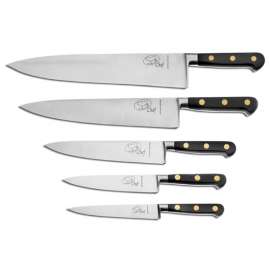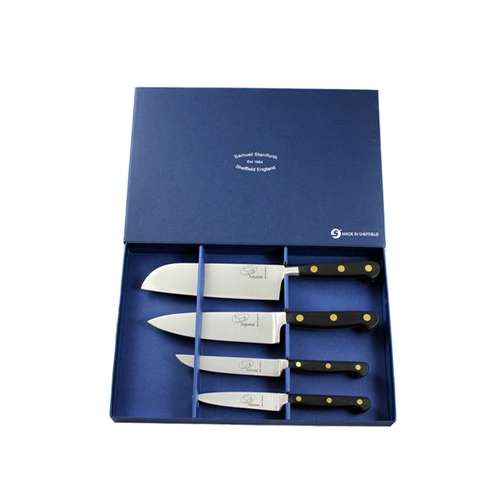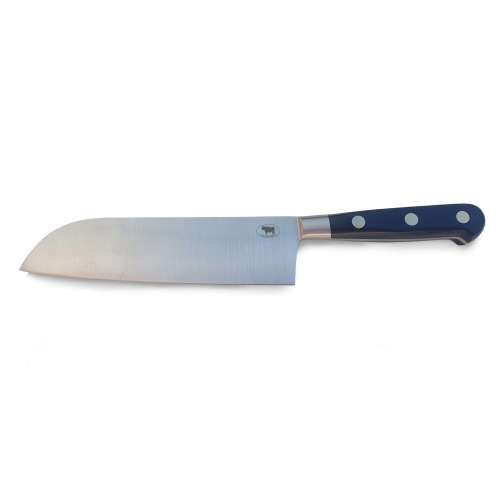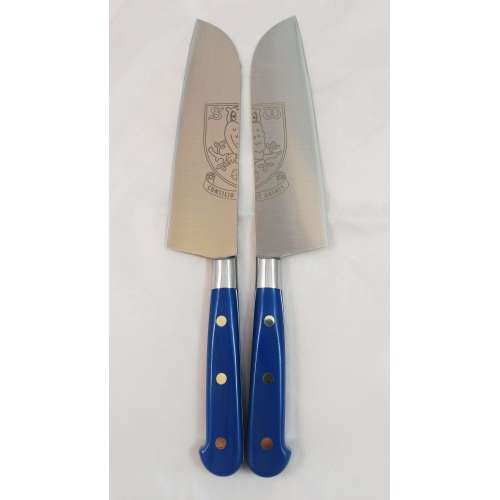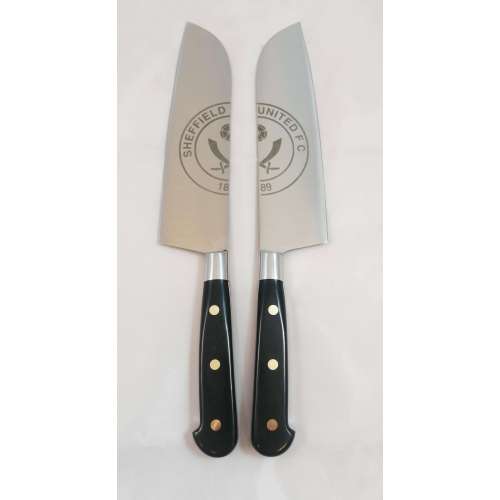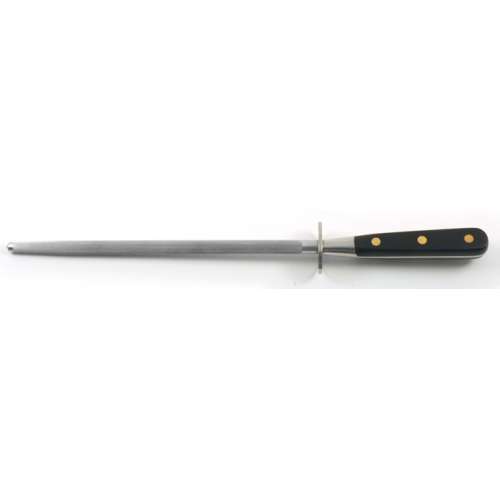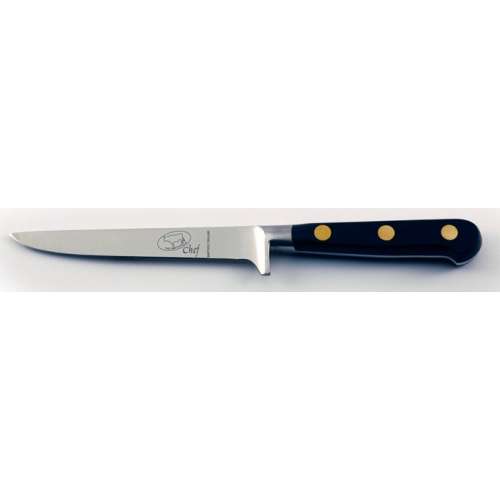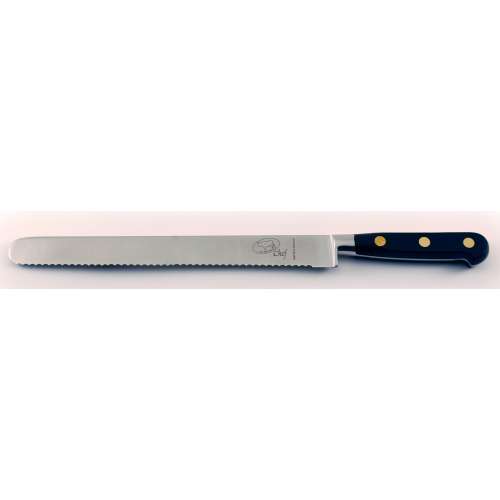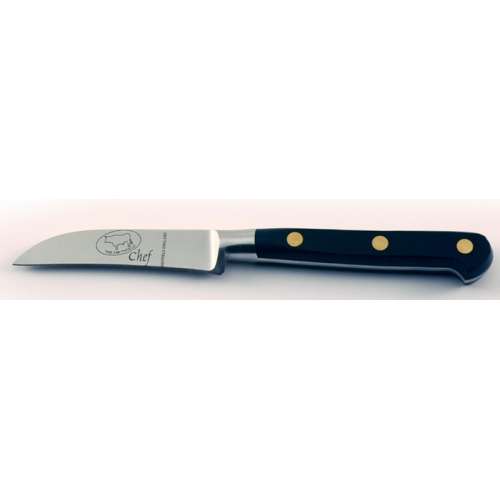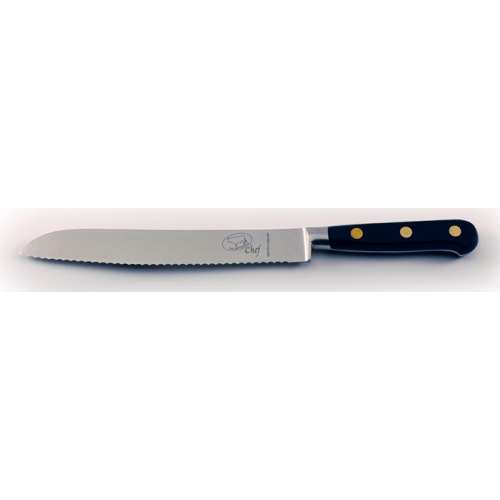No products
Product successfully added to your shopping cart
There are 0 items in your cart. There is 1 item in your cart.
Chef
Kitchen Knives
Please note that all knives are made to order.
Our Smithfield ‘Chef’ range is a superb range of fully forged, hand-finished kitchen knives, handcrafted by craftsmen with a wealth of knowledge and experience in the trade. The knives boast a traditional style of Sheffield knives which includes the fully forged blade alongside brass...
Kitchen Knives
Please note that all knives are made to order.
Our Smithfield ‘Chef’ range is a superb range of fully forged, hand-finished kitchen knives, handcrafted by craftsmen with a wealth of knowledge and experience in the trade. The knives boast a traditional style of Sheffield knives which includes the fully forged blade alongside brass rivets, which are secured by hand. This ensures that the handle is permanently secured to the tang. Our chef range also features a round bolster which counterbalances the knife to ensure it can be the perfect ally in the kitchen.
We offer a range of quality kitchen knives, from our unique 7-inch santoku knife to our limited edition Sheffield United chef knife, there is something for everyone! We also offer 4 piece kitchen knife sets if you’re looking to get fully kitted out.
Take a look at our high-quality kitchen knives below to find the right fit for you!
How Are Our Kitchen Knives Made?
Our kitchen knives are hot forged from a single piece of high carbon stainless steel X50MoV15 and precision ground to produce an end product that exhibits exceptional sharpness. Each knife is perfectly balanced, meaning that every action will feel effortless.
All of our forged blades are sharpened to 16 degrees on each side giving a razor-sharp edge that is also durable enough to withstand any professional setting. We offer handles in either traditional rosewood or black, which is then finished by hand to create a satin finish. The end result is a kitchen knife that is both solid and durable, whilst providing the perfect balance and handling required by the most demanding chefs in the industry.
Different Types of Kitchen Knife
Chef’s Knife
Chefs’ knives are used for dicing, slicing and chopping small to medium-sized ingredients such as herbs, vegetables, meat and fish. Chefs’ knives are usually the most used knife in the kitchen and are perfect for that rocking chopping motion.
Santoku Knife
Santoku roughly translates to ‘three virtues’. This is significant as a santoku knife can perform three certain tasks, (among its other attributes) splendidly. The knife has marvellous chopping, cutting and dicing abilities. Santoku has a more straight blade than a chef’s knife which allows for a more ‘up-and-down’ cutting motion.
Utility Knife
A utility knife is a highly versatile, multi-functional knife. It can be described as something in between a paring knife and a chef’s knife. They are fantastic for medium-sized jobs, like chopping small fruit, shallots, sandwiches or other things where a chef’s knife feels too big.
Paring Knife
Paring knives are ideal for peeling and slicing fruits and vegetables as well as intricate tasks such as segmenting citrus fruit. You can also get serrated paring knives (occasionally called tomato knives) which are great for easily cutting through the skin of tomatoes.
The Anatomy of a Kitchen Knife
In order to simplify the different parts of a kitchen knife, we’ve put together a set of basic definitions:
Belly - This is the part of the knife that is curved. Generally, Western-style knives tend to have a fuller belly as they’re used for a more rocking chopping motion whereas Eastern-style knives tend to have less of a belly. This is because Eastern-style knives are typically used in a straight downward motion.
Bevel Edge - It’s important to note that different types of knives will have different edges and may or may not be sharpened on both sides. Bevel edge refers to a knife that is sharpened at a sharp angle on one side.
Heel - This refers to the widest part of the knife where the blade meets the handle. It is most commonly used to chop hard items such as carrots, nuts or vegetables.
Point - This part of the blade is not used so much for chopping foods but for piercing or scoring the surface of food when preparing.
Spine - The spine refers to the top of the blade and is not used for chopping.
Tip - Not to be confused with the point, the tip of the knife is ideal for more delicate and precise cuts where less pressure is needed.
Kitchen Knife FAQs
How Many Kitchen Knives Should I Have?
If you are just starting your knife collection, we recommend investing in a few essentials that will cover your most basic kitchen tasks. These include:
Paring Knife - For topping and tailing vegetables and prepping small ingredients
Chef's Knife - A larger knife, for chopping bulky root veg, dicing and cross-chopping herbs or finely-diced meat.
Bread Knife - For tomatoes or peppers that have a shiny, slightly tough skin.
What Are The Most Common Kitchen Knife Handle Materials?
The most common kitchen knife handle materials include:
Wood - Wood is the material most commonly used to make knife handles - specifically hardwood. This is because it is naturally non-slip, warm, comfortable to the touch and aesthetically pleasing.
Plastic - Knives with plastic handles are most commonly found in commercial kitchens because they are the easiest to clean, most non-slip and therefore the safest and most sanitary. They also tend to be cheaper than wood knives.
Composite - Composite handles are often made of a mixture of resin and wood, so you get the wood effect without the maintenance.
Metal - Metal is a more uncommon choice of material for a knife handle, however, it is a very durable option. It requires no upkeep other than regular washing, they tend to be produced from one piece of metal which means they are virtually impossible to break. It should be noted however that these knives can be more dangerous as they become more slippery when the handle gets wet or oily.
What Is Material Hardness?
When talking about knives, material hardness refers to the hardness of the steel, which is measured in something called the Rockwell scale (HRC). Generally, knives range from about 52 to 58, with some very premium knives going as high as 64. As you may have guessed, the higher the number, the harder the steel. A harder steel will keep a sharp edge for longer, however, it will also be more work when you sharpen it to get the edge back.
On the flip side, a softer steel will need to be sharpened more often, but it will be much easier to get the sharp edge back. There are some disadvantages of having a knife made of very hard steel. Unfortunately, the thin edge is sensitive and can chip if used improperly or on harder to cut materials like raw squashes and potatoes
What Are Sharpening Angles?
Typically, there are two options for the angle a blade is sharpened to. Western-style knives have previously been sharpened to about a 22-degree angle and Eastern knives to about 15-16 degrees. However, you will likely find that most knives, both Western and Eastern styles, are sharpened to about a 15 degree angle nowadays.
The Eastern style knife tends to have a finer angle because of the cuisine that is often cooked in that area of the world, softer vegetables and meats. Alternatively, in the Western world, people tend to eat more root vegetables and tougher meats, which require a slightly wider angle.
What Is The Difference Between a Chef’s Knife and a Santoku Knife?
A santoku knife has a more straight and flat blade than a chef’s knife which allows for a more ‘up-and-down’ cutting motion, rather than the rocking motion we mostly use in Europe. A santoku knife will do the same things as a chef’s knife so it's completely up to you which one you prefer.
Will a Dishwasher Harm My Kitchen Knives?
Yes. Putting your kitchen knives in the dishwasher will 100% harm your kitchen knives. This is because the conditions of a dishwashing machine are too adverse. High heat, high-pressure jetting, and corrosive concentrated detergents will wreak havoc on handles, and connection points and possibly cause rusting, even on stainless steel. It's always best to wash your knives with warm soapy water, rinse them, and then dry them before putting them away.
4 Piece Gourmet Set (Chef) 4 Piece Gourmet Set (Chef)
4 Piece Knife Set Dymondwood Handles Ideal gift !! 4 Piece Knife Set Dymondwood...
(Please allow 7-14 days before dispatch as knives are made to order).7" 150 - Sheffield Wednesday 7" 150 - Sheffield Wednesday
***LIMITED EDITION***Sheffield Wednesday Chef KnifeTo all foodie football fans we are offering a bespoke limited edition Sheffield Wednesday laser etched fully forged santoku chef knives £75 each. ***LIMITED EDITION***Sheffield...
(Please allow 4-5 weeks before dispatch as knives are made to order).7" 150 - Sheffield United 7" 150 - Sheffield United
***LIMITED EDITION***Sheffield United Chef KnifeTo all foodie football fans we are offering a bespoke limited edition Sheffield United laser etched fully forged santoku chef knives £75 each to celebrate the clubs recent triumphs! ***LIMITED EDITION***Sheffield...
(Please allow 4-5 weeks before dispatch as knives are made to order).Professional Steel Professional Steel
10" Sharpening Steel - to rehone dull knives. 10" Sharpening Steel - to rehone dull...
(Please note knives are made to order).5” Chef Boning Knife 5” Chef Boning Knife
The boning knife’s purpose is described in its name. Boning knives have the ability to portion, part and remove bones in cuts of meat. This knife comes in a wide range of compositions to suit the wide range of tasks a boning knife can be used for and to suit the user’s favoured technique. The boning knife’s purpose is...
(Please note knives are made to order).Chef Serrated Slicer Chef Serrated Slicer
A slicer is a highly versatile piece of hardware it is usually longer and narrower than the average knife, this increases the flexibility of the knife. The length allows the user to produce cleaner, more precise cuts by cutting entirely through their product in a single fluid motion. A slicer is a highly versatile piece...
(Please note knives are made to order).Chef Slicer Plain Edge Chef Slicer Plain Edge
A slicer is a highly flexible piece of hardware it is usually longer and narrower than the average knife, this increases the flexibility of the knife. The length allows the user to produce cleaner, more precise cuts by cutting entirely through their product in a single fluid motion. The slicer is also highly adaptable and can have either a plain or... A slicer is a highly flexible piece...
(Please note knives are made to order).3” Turner 3” Turner
A turning knife can be used for shaping, trimming and peeling fruit and vegetables. Some say this is a far better method for peeling or paring than using a modern peeler. This knife offers perfect balance and control which makes it a crucial kitchen tool. A turning knife can be used for...
(Please note knives are made to order).8” Bread Knife 8” Bread Knife
Many professional chefs list the bread knife up in the top three knives used in food preparation, behind only the chef’s knife and the paring knife. These knives are valued highly, (as the name suggests) for their role in bread slicing, however, many people presume that just because this knife is called a bread knife it is limited to only foods that are... Many professional chefs list the...
(Please note knives are made to order).
Categories
Wishlist
Information
New products
-

Serrated Slicer PINK Handle
Versatile Slicing Knife Pink handle. Available in 8", 10", and 12"...
£ 15.75 -

-


